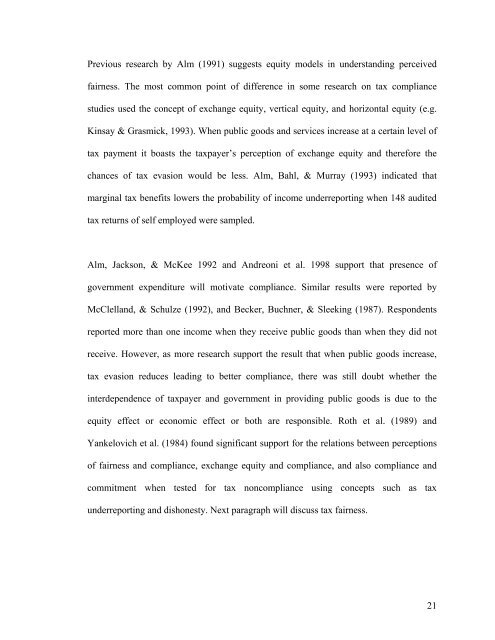1 CHAPTER 1: INTRODUCTION 1.0 Chapter ... - DSpace@UM
1 CHAPTER 1: INTRODUCTION 1.0 Chapter ... - DSpace@UM
1 CHAPTER 1: INTRODUCTION 1.0 Chapter ... - DSpace@UM
Create successful ePaper yourself
Turn your PDF publications into a flip-book with our unique Google optimized e-Paper software.
Previous research by Alm (1991) suggests equity models in understanding perceivedfairness. The most common point of difference in some research on tax compliancestudies used the concept of exchange equity, vertical equity, and horizontal equity (e.g.Kinsay & Grasmick, 1993). When public goods and services increase at a certain level oftax payment it boasts the taxpayer’s perception of exchange equity and therefore thechances of tax evasion would be less. Alm, Bahl, & Murray (1993) indicated thatmarginal tax benefits lowers the probability of income underreporting when 148 auditedtax returns of self employed were sampled.Alm, Jackson, & McKee 1992 and Andreoni et al. 1998 support that presence ofgovernment expenditure will motivate compliance. Similar results were reported byMcClelland, & Schulze (1992), and Becker, Buchner, & Sleeking (1987). Respondentsreported more than one income when they receive public goods than when they did notreceive. However, as more research support the result that when public goods increase,tax evasion reduces leading to better compliance, there was still doubt whether theinterdependence of taxpayer and government in providing public goods is due to theequity effect or economic effect or both are responsible. Roth et al. (1989) andYankelovich et al. (1984) found significant support for the relations between perceptionsof fairness and compliance, exchange equity and compliance, and also compliance andcommitment when tested for tax noncompliance using concepts such as taxunderreporting and dishonesty. Next paragraph will discuss tax fairness.21
















